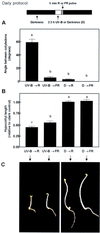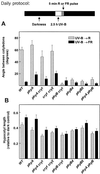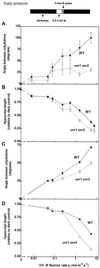Ultraviolet B radiation enhances a phytochrome-B-mediated photomorphogenic response in Arabidopsis
- PMID: 11402206
- PMCID: PMC111168
- DOI: 10.1104/pp.126.2.780
Ultraviolet B radiation enhances a phytochrome-B-mediated photomorphogenic response in Arabidopsis
Abstract
Ultraviolet B radiation (UV-B, 290-315 nm) can cause damage and induce photomorphogenic responses in plants. The mechanisms that mediate the photomorphogenic effects of UV-B are unclear. In etiolated Arabidopsis seedlings, a daily exposure to 2.5 h of UV-B enhanced the cotyledon opening response induced by a subsequent red light (R) pulse. An R pulse alone, 2.5 h of UV-B terminated with a far-red pulse, or 2.5 h of continuous R caused very little cotyledon opening. The enhancing effect of UV-B increased with fluence rate up to approximately 7.58 micromol m(-2) s(-1); at higher fluence rates the response to UV-B was greatly reduced. The phyA, phyA cry1, and cry1 cry2 mutants behaved like the wild type when exposed to UV-B followed by an R pulse. In contrast, phyB, phyB cry1, and phyB phyA mutants failed to open the cotyledons. Thus, phytochrome B was required for the cotyledon opening response to UV-B --> R treatments, whereas phytochrome A and cryptochromes 1 and 2 were not necessary under the conditions of our experiments. The enhancing effect of low doses of UV-B on cotyledon opening in uvr1 uvr2 and uvr1 uvr3 mutants, deficient in DNA repair, was similar to that found in the wild type, suggesting that this effect of UV-B was not elicited by signals derived from UV-B-induced DNA lesions (cyclobutane pyrimidine dimers and 6-4 photoproducts). We conclude that low doses of UV-B, perceived by a receptor system different from phytochromes, cryptochromes, or DNA, enhance a de-etiolation response that is induced by active phytochrome B.
Figures





References
-
- Ahmad M, Cashmore AR. HY4 gene of Arabidopsis thaliana encodes a protein with characteristics of a blue-light photoreceptor. Nature. 1993;366:162–166. - PubMed
-
- Arawaka O. Photoregulation of anthocyanin synthesis in apple fruit under UV-B and red light. Plant Cell Physiol. 1988;29:1385–1389.
-
- Ballaré CL, Barnes PW, Flint SD. Inhibition of hypocotyl elongation by ultraviolet-B radiation in de-etiolating tomato seedlings: I. The photoreceptor. Physiol Plant. 1995;93:584–592.
-
- Beggs CJ, Wellmann E. Analysis of light-controlled anthocyanin formation in coleoptiles of Zea mays L.: the role of UV-B, blue, red and far-red light. Photochem Photobiol. 1985;41:481–486.
-
- Beggs CJ, Wellmann E. Photocontrol of flavonoid biosynthesis. In: Kendrick RE, Kronenberg GHM, editors. Photomorphogenesis in Plants. Dordrecht, The Netherlands: Kluwer Academic Publishers; 1994. pp. 733–751.
Publication types
MeSH terms
Substances
LinkOut - more resources
Full Text Sources
Molecular Biology Databases

